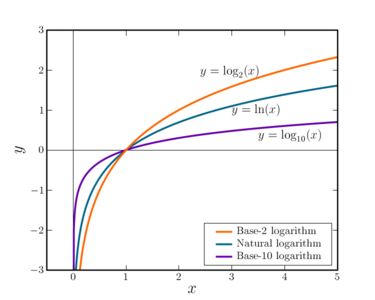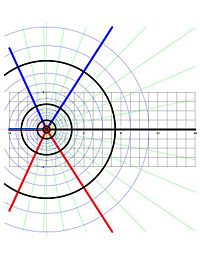Logarithm: Difference between revisions
imported>Dmitrii Kouznetsov |
imported>Dmitrii Kouznetsov m (Oops.. All contnent twice. Remove one....) |
||
| Line 129: | Line 129: | ||
<!-- [[Category:Mathematical functions]]!--> | <!-- [[Category:Mathematical functions]]!--> | ||
[[Category:Elementary functions]] | [[Category:Elementary functions]] | ||
[[Category:All content]] | <!-- [[Category:All content]] !--> | ||
Revision as of 17:40, 30 October 2008
Logarithm or log, is mathematical function, inverse of exponential function, holomorphic in the whole complex plane, except singularity at zero and cut at the negative part of the real axis. Roughly, logarithm of number on the base counts, how many times the base should be multiplied by itself in order to get . However, this function can be extended to non-integer values of : real, complex, matrices, etc.
Evaluation of logarithm
Computing logarithms is the inverse of exponentiation, as subtraction is the inverse of addition and division is the inverse of multiplication. For example, since , then the base-7 logarithm of 343 is 3. In general, if , then where is called the base and is the logarithm. In other words, the logarithm is the exponential power to which the base must be raised to produce the number .[1][2][3]
Logarithms show up in a variety of scientific formulas: for example, the number of bits required to represent the address of a particular location in computer memory is equal to the base-2 logarithm (rounded upwards) of the number of possible locations. Logarithms are also useful for representing large numbers in a more manageable form.
Logarithms of intermediate and fractional values
Because we use a base-10 number system, it is often convenient to use 10 as the base of the logarithm. It's easy to find the base-10 logarithm of a number such as 1000, because therefore (The value of the logarithmic function is the number that appeared as an exponent in the other equation.) But what is the logarithm of a number such as 43, or 0.001?
We know from the study of exponents that, for example, is and this then supplies a value for Values for many other numbers can be worked out similarly using cube roots and so on, and values for all real numbers can then be defined using limits. For example, is approximately equal to 1.63347. Multiplying a number by 10 appends a zero to the numeral and adds 1 to the base-10 logarithm, therefore is approximately 2.63347.
and it then follows that
or in general,
By a similar argument it can be established that for any base and therefore that
Thus, logarithms of numbers between 0 and 1 are negative numbers, the logarithm of 1 is 0, and logarithms of numbers greater than 1 are positive real numbers as seen in the image below.
Shape of the logarithm function
Consider the function where b is a real-number base greater than 1 of the logarithm. Since any positive real number raised to the exponent zero is 1, the logarithm of 1 is zero. To the right of 1 on the x-axis, the function continually increases, but increases more and more slowly as heads towards infinity. Between 1 and 0, the logarithmic function has negative values, and asymptotically approaches minus infinity as approaches zero. For negative values of , there is no defined value of within the real numbers — but using complex numbers a value can be found, as will be discussed further below.
Manipulating logarithms
Suppose we know the logarithm of a number using one base , and we want to find the logarithm using a different base :
- ?
Suppose we know , and and we want to find . We need to look up the value of , and then by multiplying we can find the desired quantity:
This formula can be established using the definition of logarithms and the rule for multiplying exponents:
Substituting for b,
Therefore , the formula we wished to prove.
A useful formula for can be derived using the rule for adding exponents:
Therefore :
Other useful formulas include these identities:
Bases and notational variants
The base must not be 0 nor 1. The most widely used bases for logarithms are 10, 2 and the transcendental number (also known as Euler's number) which is approximately 2.7182818284.
When logarithms are used to measure physical values (e.g., when noise is measured in deciBels) it is common to use 10 as a base, and in these contexts, the notation means .
Mathematicians and physicists often find, however, that is more convenient as a base for a logarithmic function. The logarithmic function with as a base is called the natural logarithm; it has the special property that its derivative is . The notation is often used for natural logarithms, but in mathematics it is just as common to use the notation and write logarithms to base 10 using the full notation .
Computer science adds a whole new wrinkle because, in some cases, it is most useful to consider logarithms to base 2, and this has led to a new notation which become common for logarithms to a base of 2. Finally, the notation is sometimes used for logarithms to base 2, but this is usage is less common.
In German and Russian literature, is used to mean the common logarithm .[4] The advice of the United States Department of Commerce's National Institute of Standards and Technology is to follow the ISO standard Mathematical signs and symbols for use in physical sciences and technology, ISO 31-11:1992, which suggests these notations:[5]
- The notation means
- The notation means
- The notation means
It is obvious that, until a standard such as the ISO standard is universally accepted, perhaps the surest way to avoid confusion is to always use the notation of , , or , whichever is applicable.
Complex numbers and logarithms
The exponential function of an imaginary number is given as
Consequently if a and b are real numbers then
The sine and cosine functions are not one-to-one and hence neither is this complex exponential function. Therefore it has no inverse function, as the concept of "function" is generally defined in the present day. However, one may speak of the logarithm as being a multiple-valued function (strictly speaking, an oxymoronic term by current conventions).
To find the logarithm of a complex number , it is convenient to express the number in polar coordinates where and . (Intuitively, is the length of the line segment joining the number to the origin in the complex plane, and is the angle that line segment makes with the -axis). The equivalence of the two notations is given by
Let us define so that . Using the formula for the exponential function above,
It can be seen from similarity with the above formula for polar coordinates that and . Therefore,
This is "multiple-valued" because the arctangent function is "multiple-valued". If is a value of then is also a value of the "function" for any integer . A single-valued function can be obtained by, for example, restricting the values of the function to . In this case, the complex logarithm function has a discontinuity along the negative -axis (see figure).
In this way, the domain of the logarithmic function can be extended to cover the entire complex plane except for the number zero, which has an undefined value — a singularity with the real part plunging towards minus infinity and the imaginary part spinning wildly like a compass at the North Pole.
History
The method of logarithms was first publicly propounded in 1614, in a book entitled Mirifici Logarithmorum Canonis Descriptio, by John Napier, Baron of Merchiston, in Scotland.[7]
Jost Bürgi, a Swiss mathematician, independently discovered logarithms but did not publish his discovery until four years after Napier.[8]
Early resistance to the use of logarithms was muted by the support of Johannes Kepler, the German mathematician and astronomer, who published a clear and impeccable explanation in 1624 of how logarithms worked.[9]
The use of logarithms contributed to the advance of science, and especially of astronomy, by making some difficult calculations possible. Prior to the advent of electronic calculators and computers, logarithms were used extensively in surveying, navigation, engineering, chemistry and many other disciplines.
References
- ↑ Stan Gibilisco and Norman H. Crowhurst (2007). Mastering Technical Mathematics, 3rd Edition. McGraw-Hill. ISBN 0-07-149448-0.
- ↑ Robert C. Weast (Editor) (1975). Handbook of Chemistry and Physics, 56th Edition. CRC Press. ISBN 0-87819-455-X.
- ↑ Staff of the REA (1999). Math Made Nice and Easy (Book 2). Research and Education Association (REA), pages 232-246. ISBN 0-87891-201-0.
- ↑ Lg at Mathworld
- ↑ B. N. Taylor (1995). Guide for the Use of the International System of Units (SI). NIST Special Publication 811, 1995 Edition. US Department of Commerce.
- ↑ John Napier The History of Computing Project
- ↑ Did you know? (Website of the University of Arkansas at Little Rock, Arkansas)
- ↑ Jost Bürgi (Website of the University of St. Andrews, Scotland)
- ↑ Johannes Kepler (Website of the University of St. Andrews, Scotland)








































![{\displaystyle \log _{b}({\sqrt[{y}]{x}})={\frac {\log _{b}(x)}{y}}}](https://wikimedia.org/api/rest_v1/media/math/render/svg/fbb5fcbb3fb6949b7a9549bd3d8cf128843f3cf3)








































